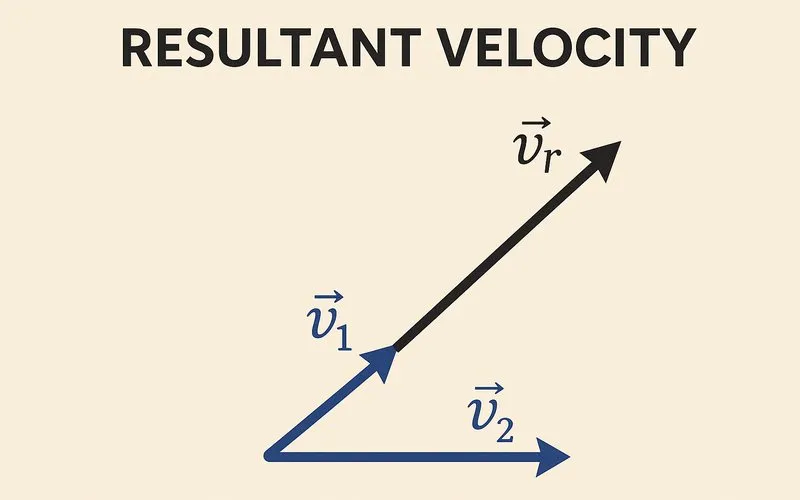Resultant Velocity: Finding the Single Vector Sum
What Are Vectors and Scalars?
Before we can add velocities, we must understand what kind of quantity velocity is. In physics, we classify quantities as either scalars or vectors.
| Type | Definition | Examples |
|---|---|---|
| Scalar | A quantity that has only magnitude (size). | Time, mass, temperature, distance, speed. |
| Vector | A quantity that has both magnitude and direction. | Displacement, velocity, acceleration, force. |
Speed is a scalar (e.g., 60 km/h). Velocity is a vector (e.g., 60 km/h north). Because velocity has direction, we cannot simply add numbers together. We must use vector addition to find the resultant velocity.
Methods for Finding the Resultant Velocity
There are several ways to find the resultant velocity, each useful in different situations. The two most common methods are the graphical method and the mathematical method.
1. The Graphical Method (Tip-to-Tail)
This method involves drawing the velocity vectors to scale. Imagine you are walking at 4 m/s east and then turn to walk 3 m/s north. Your resultant velocity is not 7 m/s!
- Draw the first vector (e.g., 4 m/s east) as an arrow pointing to the right.
- From the tip (head) of the first arrow, draw the second vector (e.g., 3 m/s north) pointing upwards.
- The resultant vector is the arrow drawn from the tail of the first vector to the tip of the last vector.
If you measure this resultant arrow, you would find it has a length corresponding to 5 m/s and points in a northeasterly direction.
2. The Mathematical Method (Pythagorean Theorem)
When two velocities are at a right angle (90°) to each other, we can use the Pythagorean theorem. For our walking example:
So, $R = \sqrt{(4)^2 + (3)^2} = \sqrt{16 + 9} = \sqrt{25} = 5$ m/s.
To find the direction, we use trigonometry. The angle $\theta$ north of east is given by $\tan(\theta) = \frac{opposite}{adjacent} = \frac{3}{4}$. Therefore, $\theta = \tan^{-1}(\frac{3}{4}) \approx 37°$.
Real-World Applications of Resultant Velocity
The concept of resultant velocity is not just a theoretical idea; it is used daily in navigation and transportation.
The Classic River Crossing Problem
Imagine a boat that can move at 5 m/s in still water. The boat captain points the boat directly across a river that flows at 3 m/s. The boat has two simultaneous velocities:
- Velocity due to the boat's engine: 5 m/s across the river.
- Velocity due to the river current: 3 m/s downstream.
These two velocities are perpendicular. The resultant velocity of the boat is found using the Pythagorean theorem:
$R = \sqrt{5^2 + 3^2} = \sqrt{25 + 9} = \sqrt{34} \approx 5.83$ m/s.
The boat will not land directly across from its starting point. Instead, it will follow a diagonal path downstream. The direction of this path is at an angle $\theta = \tan^{-1}(\frac{3}{5}) \approx 31°$ downstream from the line directly across the river.
Airplane Navigation in a Crosswind
Pilots must constantly calculate resultant velocity. Suppose an airplane aims to fly due north at 200 km/h. If a strong wind is blowing from the west to the east at 50 km/h, the plane's actual path will be deflected.
- Plane's velocity (air speed): 200 km/h north.
- Wind's velocity: 50 km/h east.
The resultant ground velocity is $R = \sqrt{200^2 + 50^2} = \sqrt{40000 + 2500} = \sqrt{42500} \approx 206$ km/h, in a direction $\theta = \tan^{-1}(\frac{50}{200}) = \tan^{-1}(0.25) \approx 14°$ east of north. To compensate and fly truly north, the pilot must point the plane's nose slightly into the wind (west of north).
Common Mistakes and Important Questions
Q: Is the resultant velocity always greater than the individual velocities?
A: No, not always. The resultant velocity's magnitude depends on the directions of the individual velocities. If two velocities are in the same direction, the resultant is the sum of the magnitudes (larger). If they are in opposite directions, the resultant is the difference (smaller). If they are at an angle, the resultant is somewhere in between, as calculated by the Pythagorean theorem or other vector methods.
Q: What is the difference between average velocity and resultant velocity?
A: Average velocity is the total displacement divided by the total time for a journey that may involve changing velocities. Resultant velocity is the single, combined velocity of an object at a given instant when it is subject to multiple simultaneous motions. Resultant velocity is an instantaneous vector sum.
Q: Can the resultant velocity be zero?
A: Yes! If two equal and opposite velocities act on an object, the resultant velocity is zero. For example, if you walk east at 1 m/s on a conveyor belt moving west at 1 m/s, you will remain stationary relative to the ground. The vectors cancel each other out.
Footnote
1 Vector: A physical quantity defined by both its magnitude (size) and its direction. Examples include force, displacement, and velocity.
2 Scalar: A physical quantity that is defined solely by its magnitude, with no associated direction. Examples include mass, temperature, and speed.
3 Pythagorean Theorem: A fundamental relation in geometry between the three sides of a right triangle. It states that the square of the hypotenuse (the side opposite the right angle) is equal to the sum of the squares of the other two sides: $a^2 + b^2 = c^2$.

